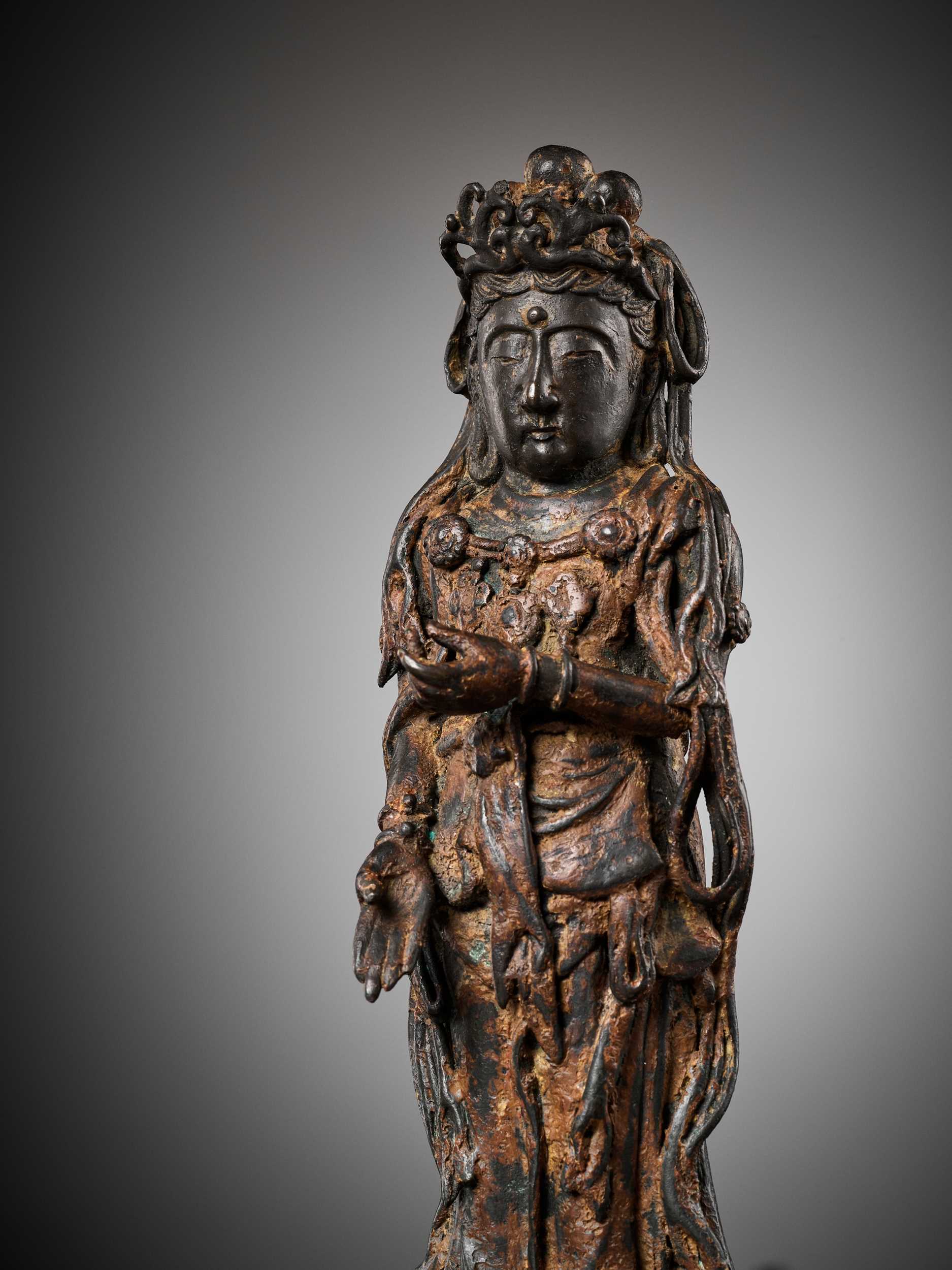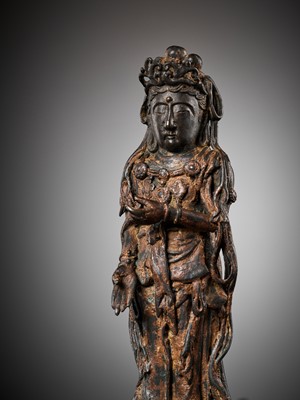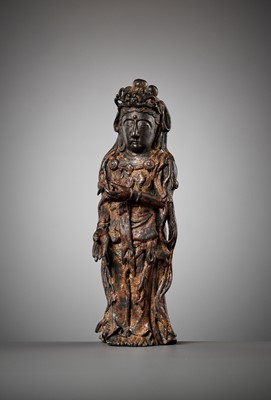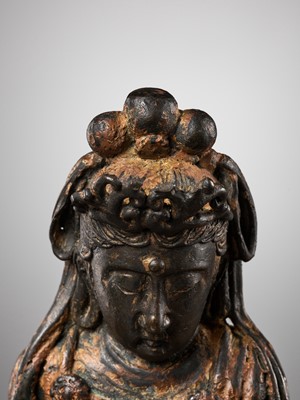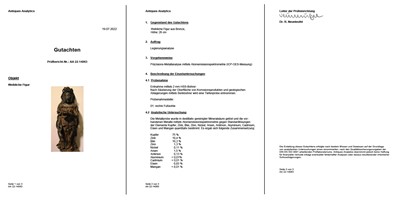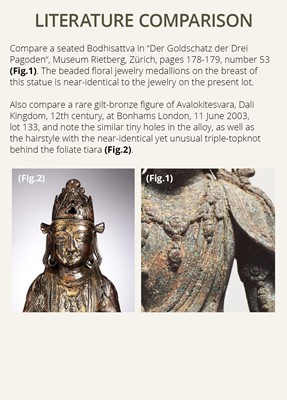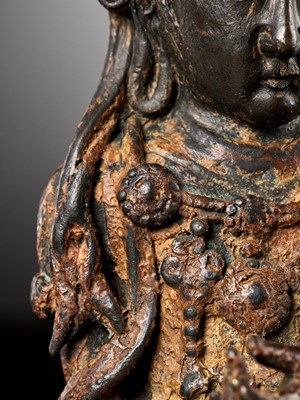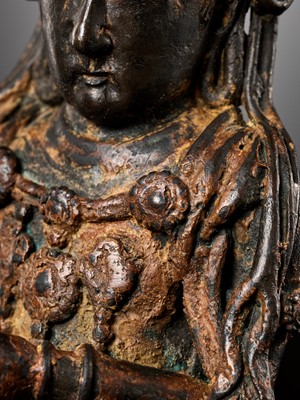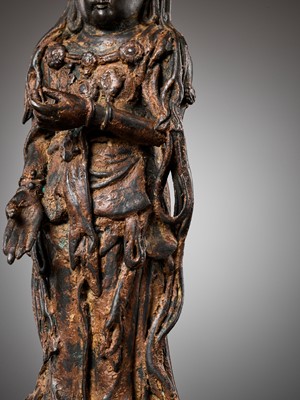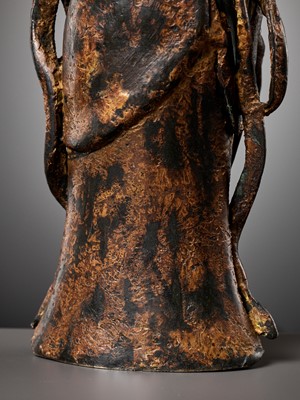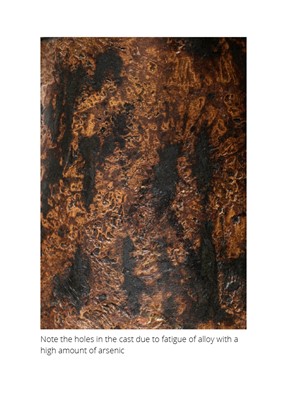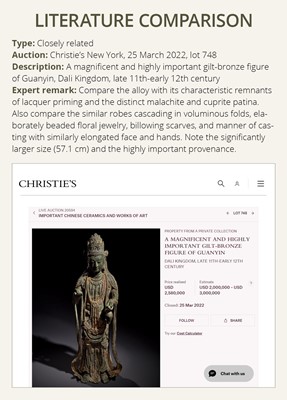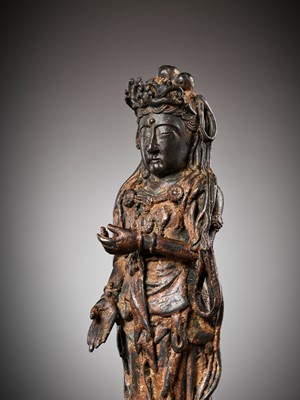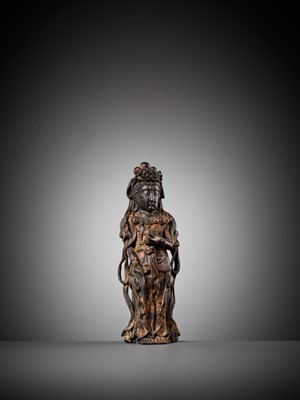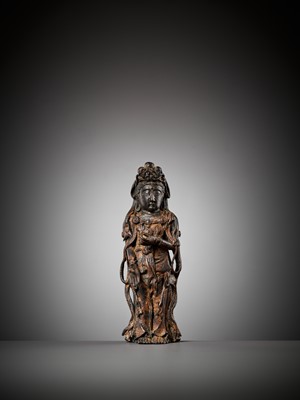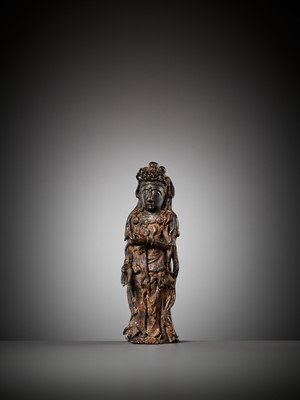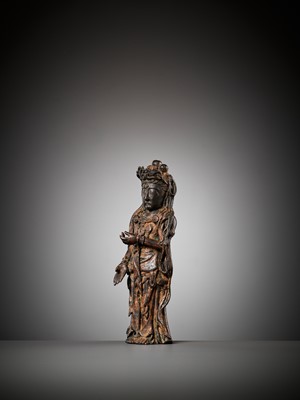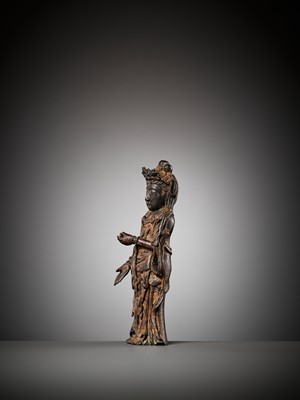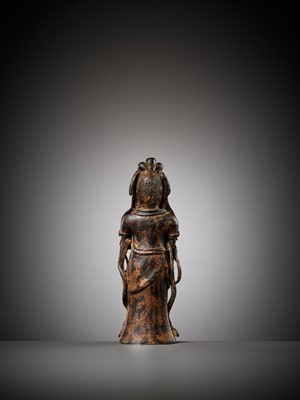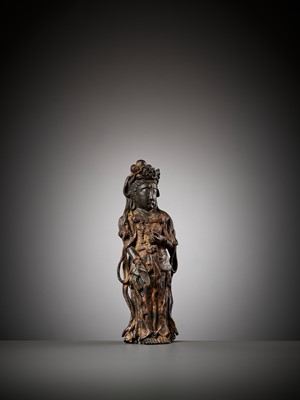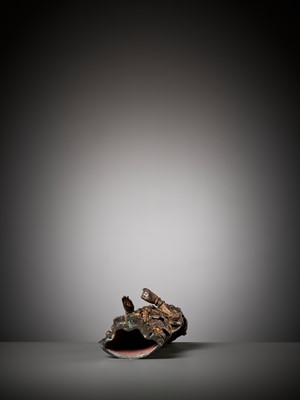2nd Jun, 2023 11:00
Fine Chinese Art / 中國藝術集珍 / Buddhism & Hinduism
143
AN EXCEEDINGLY RARE BRONZE FIGURE OF GUANYIN, DALI KINGDOM, 12TH – MID-13TH CENTURY
大理國罕見觀音銅像
Sold for €8,450
including Buyer's Premium
Expert’s note: A unique feature of copper alloys from Yunnan is the high content of arsenic, making the bronze quite soft, and leading to tiny holes in the material. Alloys from other regions do not develop this compelling tell which is clearly visible in the present lot.
A metallurgic analysis of the present lot has shown an arsenic content of 1.5%, which is remarkably elevated. A comprehensive analysis of 32 Chinese copper alloy figures from the collection of the Metropolitan Museum of Art, New York, dating from the 4th to the 19th century, has found that only two statues had an arsenic content of above 1.2%. Both these statues are from Yunnan and date to the 11th-12th century. Only five of the other 30 figures showed an arsenic content between 0,5 and 1,2%, all others were below this value, most of them significantly. (1)
A comprehensive metallurgic analysis of six near-identical copper alloy figures of Acuoye Guanyin from Yunnan in the collections of the Freer Gallery of Art, Washington, the San Diego Museum of Art, the Art institute of Chicago, and the collection of Robert Ellsworth, New York, has returned arsenic contents ranging between 0,53 and 3,08% with an average of 1.89%. (2)
As Paul Jett notes, it seems more likely that the singularly high arsenic content in the copper alloys from Yunnan is of natural origin, instead of being a deliberate addition, because sulfide-deposits, where arsenic appears in combination with copper, are widespread in this specific region. (3)
For the aforementioned reasons, it seems reasonable to assume that copper alloy statues with an elevated arsenic content of 1% or more are from Yunnan when they show stylistic traits characteristic of this region. Features typical of statues from the Dali Kingdom found on the present lot include for example the unusually elongated face, the minuscule yet razor sharp eye slits, the elaborate headdress with its distinct triple-topknot, the beaded floral jewelry medallions on the breast and the lengthy, almost frail hands that still show the undeniable influence of Indian and Southeast Asian Buddhist images, which at that time had already vanished from the more important centers of Chinese Buddhism.
The metallurgic analysis of the present lot furthermore returned a copper share of 75% as well as contents of lead (10%) and zinc (10%). While a zinc content of 10% may be unusual at first glance, it must be noted that coins of the Song dynasty were found to contain Zinc (4) and copper alloys with high levels of zinc eventually became so popular during this period, that they were prohibited by the government for commoners. (5) The Song empire was the eastern neighbor of the Dali Kingdom, and Dali's relationship with the Song was cordial throughout its entire existence, with cultural and economic exchange taking place on multiple levels. In the early Ming dynasty, highly elevated zinc contents of up to 36,4% were found for example in Imperial Xuande period censers dating from 1426-1435. (6)
References:
(1) Wisdom Embodied: Chinese Buddhist and Daoist Sculpture in The Metropolitan Museum of Art, New York, Denise Patry Leidy and Donna Strahan, Yale University Press, 2010, appendix D, pages 206-207.
(2) Der Goldschatz der drei Pagoden, Museum Rietberg Zürich, Albert Lutz, 1991 .Paul Jett: Technologische Studie zu den vergoldeten Guanyin-Figuren aus dem Dali-Königreich, page 73.
(3) Ibidem, page 71.
(4) Distilling Zinc in China: The technology of large-scale zinc production in Chongqing during the Ming and Qing dynasties (AS 1368-1911), Wenli Zhou, University College London, 2012, page 26.
(5) Ibidem, page 39.
(6) Ibidem, page 46-47.
China, Yunnan, Kingdom of Dali, 12th – mid-13th century. Superbly cast standing with her right hand lowered in varada mudra and her left held in front, wearing long flowing robes cascading in voluminous folds and billowing scarves, richly adorned with elaborate beaded and floral jewelry. Her elongated serene face with heavy-lidded, almost fully closed eyes centered by a prominent urna above gently arched brows. The hair falling elegantly in strands over the shoulders and pulled up into a distinct triple-topknot behind the pierced foliate tiara.
Provenance: Old Viennese private collection, built over several generations between 1910 and 1975, thence by descent in the same family.
Condition: Very good condition, commensurate with age and displaying remarkably well. Extensive wear, minor losses, nicks, scratches, minuscule dents, signs of weathering and erosion, remnants of lacquer priming with malachite and cuprite patina.
Weight: 1,458 g
Dimensions: Height 25.8 cm
It was not until the American scholar Helen Chapin identified a group of bronzes in western collections as being of Yunnanese origin, based on a scroll painting known as the Long Scroll of Buddhist Images by the 12th-century Yunnanese artist Zhang Shengwen, which she published in 1944, that the origin of these distinctive Dali or Yunnanese bronzes was first realized. In the late 1970s, restoration work at the Qianxun Pagoda in Yunnan province uncovered a reliquary deposit which included a number of statues similar in style to those in the West, see A. Lutz, 'Buddhist Art in Yunnan', Orientations, February 1992.
Literature comparison:
Compare a seated Bodhisattva in “Der Goldschatz der Drei Pagoden“, Museum Rietberg, Zürich, pages 178-179, number 53 (Fig.1). The beaded floral jewelry medallions on the breast of this statue is near-identical to the jewelry on the present lot. Also compare a rare gilt-bronze figure of Avalokitesvara, Dali Kingdom, 12th century, at Bonhams London, 11 June 2003, lot 133, and note the similar tiny holes in the alloy, as well as the hairstyle with the near-identical yet unusual triple-topknot behind the foliate tiara (Fig.2).
Literature comparison:
Type: Related
Auction: Christie’s New York, 25 March 2022, lot 748
Description: A magnificent and highly important gilt-bronze figure of Guanyin, Dali Kingdom, late 11th-early 12th century
Expert remark: Compare the alloy with its characteristic remnants of lacquer priming and the distinct malachite and cuprite patina. Also compare the similar robes cascading in voluminous folds, elaborately beaded floral jewelry, billowing scarves, and manner of casting with similarly elongated face and hands. Note the significantly larger size (57.1 cm) and the highly important provenance.
大理國罕見觀音銅像
中國,雲南,大理王國,十二世紀至十三世紀中期。該像法相威儀,觀音跣足而立,右手低垂結與願印,左手置於胸前。身著飄逸的長袍,線條流暢,佩戴瓔珞。觀音面部平靜慈祥,雙眼微垂,雙眉之間有白毫。頭髮披肩,葉冠后高髻。
專家注釋:大理國銅器的一個獨特之處是合金中的砷含量高,使銅質變得柔軟,並因合金產生微小的孔洞。後來的銅器和其他地區的銅器沒有這個特徵,這在本拍品和同類銅造像器中清晰可見(見拍賣結果比較)。大理銅造像的風格包括細長的臉、精緻的頭飾和纖柔的手,這些特徵仍然顯示出印度和東南亞佛教造像的影響。
文獻參考:
(1) Denise Patry Leidy,Donna Strahan,《Wisdom Embodied: Chinese Buddhist and Daoist Sculpture in The Metropolitan Museum of Art》,紐約,耶魯大學出版社, 2010年,頁206-207。
(2) Albert Lutz,《Der Goldschatz der drei Pagoden》,蘇黎世Rietberg博物館, 1991年。Paul Jett,《Technologische Studie zu den vergoldeten Guanyin-Figuren aus dem Dali-Königreich》,頁73。
(3) 同上本書,頁71。
(4) Wenli Zhou,《Distilling Zinc in China: The technology of large-scale zinc production in Chongqing during the Ming and Qing dynasties (AS 1368-1911)》,倫敦大學學院2012年,頁26。
(5) 同上本書,頁39。
(6) 同上本書,頁46-47。
來源:維也納私人舊藏,整個收藏構建與1910-1975年間,歷經幾代人,保存在同一家族至今。
品相:狀況極好,與年代相吻合。大面積磨損、輕微缺損、刻痕、劃痕、微小凹痕、風化和侵蝕跡象,紅綠色銅鏽。
重量:1,458 克
尺寸:高25.8 厘米
直到美國學者Helen Chapin根據十二世紀雲南畫師大理國張勝溫《梵像卷》羅漢畫確定了一批西方收藏中的銅像源自雲南,並於 1944 年出版,首次確認這些獨特的大理或雲南銅器的起源。1970 年代後期,雲南省千尋塔的修復工作進展中發現了一個聖髑盒庫,其中有很多與那些西方收藏中的造像風格相似,見 A. Lutz,《'Buddhist Art in Yunnan》(雲南佛教藝術),Orientations,1992 年 2 月。
文獻比較:
比較一件觀音坐像,見蘇黎世Rietberg博物館,《Der Goldschatz der Drei Pagoden》,蘇黎世,頁178-179,編號53(圖1)。其垂掛於胸前的瓔珞形態幾乎與現拍品相同。比較一件公元十二世紀大理王國鎏金觀音銅像,見倫敦邦瀚斯,2003年6月11日,lot 133;請注意合金上有小孔,幾乎相近的葉冠後三高髻髮型(圖2)。
文獻比較:
形制:相近
拍賣:紐約佳士得,2022年3月25日,lot 748
描述:十一世紀晚期至十二世紀初期大理王國鎏金觀音銅像
專家評論:比較合金上的顏料殘餘和紅綠色銅鏽。比較相近的長袍,大量的皺褶、精巧的瓔珞裝飾、飄逸的圍巾,以及臉和手類似的鑄造風格。請注意尺寸較大(57.1 厘米),以及重要的來源。
Expert’s note: A unique feature of copper alloys from Yunnan is the high content of arsenic, making the bronze quite soft, and leading to tiny holes in the material. Alloys from other regions do not develop this compelling tell which is clearly visible in the present lot.
A metallurgic analysis of the present lot has shown an arsenic content of 1.5%, which is remarkably elevated. A comprehensive analysis of 32 Chinese copper alloy figures from the collection of the Metropolitan Museum of Art, New York, dating from the 4th to the 19th century, has found that only two statues had an arsenic content of above 1.2%. Both these statues are from Yunnan and date to the 11th-12th century. Only five of the other 30 figures showed an arsenic content between 0,5 and 1,2%, all others were below this value, most of them significantly. (1)
A comprehensive metallurgic analysis of six near-identical copper alloy figures of Acuoye Guanyin from Yunnan in the collections of the Freer Gallery of Art, Washington, the San Diego Museum of Art, the Art institute of Chicago, and the collection of Robert Ellsworth, New York, has returned arsenic contents ranging between 0,53 and 3,08% with an average of 1.89%. (2)
As Paul Jett notes, it seems more likely that the singularly high arsenic content in the copper alloys from Yunnan is of natural origin, instead of being a deliberate addition, because sulfide-deposits, where arsenic appears in combination with copper, are widespread in this specific region. (3)
For the aforementioned reasons, it seems reasonable to assume that copper alloy statues with an elevated arsenic content of 1% or more are from Yunnan when they show stylistic traits characteristic of this region. Features typical of statues from the Dali Kingdom found on the present lot include for example the unusually elongated face, the minuscule yet razor sharp eye slits, the elaborate headdress with its distinct triple-topknot, the beaded floral jewelry medallions on the breast and the lengthy, almost frail hands that still show the undeniable influence of Indian and Southeast Asian Buddhist images, which at that time had already vanished from the more important centers of Chinese Buddhism.
The metallurgic analysis of the present lot furthermore returned a copper share of 75% as well as contents of lead (10%) and zinc (10%). While a zinc content of 10% may be unusual at first glance, it must be noted that coins of the Song dynasty were found to contain Zinc (4) and copper alloys with high levels of zinc eventually became so popular during this period, that they were prohibited by the government for commoners. (5) The Song empire was the eastern neighbor of the Dali Kingdom, and Dali's relationship with the Song was cordial throughout its entire existence, with cultural and economic exchange taking place on multiple levels. In the early Ming dynasty, highly elevated zinc contents of up to 36,4% were found for example in Imperial Xuande period censers dating from 1426-1435. (6)
References:
(1) Wisdom Embodied: Chinese Buddhist and Daoist Sculpture in The Metropolitan Museum of Art, New York, Denise Patry Leidy and Donna Strahan, Yale University Press, 2010, appendix D, pages 206-207.
(2) Der Goldschatz der drei Pagoden, Museum Rietberg Zürich, Albert Lutz, 1991 .Paul Jett: Technologische Studie zu den vergoldeten Guanyin-Figuren aus dem Dali-Königreich, page 73.
(3) Ibidem, page 71.
(4) Distilling Zinc in China: The technology of large-scale zinc production in Chongqing during the Ming and Qing dynasties (AS 1368-1911), Wenli Zhou, University College London, 2012, page 26.
(5) Ibidem, page 39.
(6) Ibidem, page 46-47.
China, Yunnan, Kingdom of Dali, 12th – mid-13th century. Superbly cast standing with her right hand lowered in varada mudra and her left held in front, wearing long flowing robes cascading in voluminous folds and billowing scarves, richly adorned with elaborate beaded and floral jewelry. Her elongated serene face with heavy-lidded, almost fully closed eyes centered by a prominent urna above gently arched brows. The hair falling elegantly in strands over the shoulders and pulled up into a distinct triple-topknot behind the pierced foliate tiara.
Provenance: Old Viennese private collection, built over several generations between 1910 and 1975, thence by descent in the same family.
Condition: Very good condition, commensurate with age and displaying remarkably well. Extensive wear, minor losses, nicks, scratches, minuscule dents, signs of weathering and erosion, remnants of lacquer priming with malachite and cuprite patina.
Weight: 1,458 g
Dimensions: Height 25.8 cm
It was not until the American scholar Helen Chapin identified a group of bronzes in western collections as being of Yunnanese origin, based on a scroll painting known as the Long Scroll of Buddhist Images by the 12th-century Yunnanese artist Zhang Shengwen, which she published in 1944, that the origin of these distinctive Dali or Yunnanese bronzes was first realized. In the late 1970s, restoration work at the Qianxun Pagoda in Yunnan province uncovered a reliquary deposit which included a number of statues similar in style to those in the West, see A. Lutz, 'Buddhist Art in Yunnan', Orientations, February 1992.
Literature comparison:
Compare a seated Bodhisattva in “Der Goldschatz der Drei Pagoden“, Museum Rietberg, Zürich, pages 178-179, number 53 (Fig.1). The beaded floral jewelry medallions on the breast of this statue is near-identical to the jewelry on the present lot. Also compare a rare gilt-bronze figure of Avalokitesvara, Dali Kingdom, 12th century, at Bonhams London, 11 June 2003, lot 133, and note the similar tiny holes in the alloy, as well as the hairstyle with the near-identical yet unusual triple-topknot behind the foliate tiara (Fig.2).
Literature comparison:
Type: Related
Auction: Christie’s New York, 25 March 2022, lot 748
Description: A magnificent and highly important gilt-bronze figure of Guanyin, Dali Kingdom, late 11th-early 12th century
Expert remark: Compare the alloy with its characteristic remnants of lacquer priming and the distinct malachite and cuprite patina. Also compare the similar robes cascading in voluminous folds, elaborately beaded floral jewelry, billowing scarves, and manner of casting with similarly elongated face and hands. Note the significantly larger size (57.1 cm) and the highly important provenance.
大理國罕見觀音銅像
中國,雲南,大理王國,十二世紀至十三世紀中期。該像法相威儀,觀音跣足而立,右手低垂結與願印,左手置於胸前。身著飄逸的長袍,線條流暢,佩戴瓔珞。觀音面部平靜慈祥,雙眼微垂,雙眉之間有白毫。頭髮披肩,葉冠后高髻。
專家注釋:大理國銅器的一個獨特之處是合金中的砷含量高,使銅質變得柔軟,並因合金產生微小的孔洞。後來的銅器和其他地區的銅器沒有這個特徵,這在本拍品和同類銅造像器中清晰可見(見拍賣結果比較)。大理銅造像的風格包括細長的臉、精緻的頭飾和纖柔的手,這些特徵仍然顯示出印度和東南亞佛教造像的影響。
文獻參考:
(1) Denise Patry Leidy,Donna Strahan,《Wisdom Embodied: Chinese Buddhist and Daoist Sculpture in The Metropolitan Museum of Art》,紐約,耶魯大學出版社, 2010年,頁206-207。
(2) Albert Lutz,《Der Goldschatz der drei Pagoden》,蘇黎世Rietberg博物館, 1991年。Paul Jett,《Technologische Studie zu den vergoldeten Guanyin-Figuren aus dem Dali-Königreich》,頁73。
(3) 同上本書,頁71。
(4) Wenli Zhou,《Distilling Zinc in China: The technology of large-scale zinc production in Chongqing during the Ming and Qing dynasties (AS 1368-1911)》,倫敦大學學院2012年,頁26。
(5) 同上本書,頁39。
(6) 同上本書,頁46-47。
來源:維也納私人舊藏,整個收藏構建與1910-1975年間,歷經幾代人,保存在同一家族至今。
品相:狀況極好,與年代相吻合。大面積磨損、輕微缺損、刻痕、劃痕、微小凹痕、風化和侵蝕跡象,紅綠色銅鏽。
重量:1,458 克
尺寸:高25.8 厘米
直到美國學者Helen Chapin根據十二世紀雲南畫師大理國張勝溫《梵像卷》羅漢畫確定了一批西方收藏中的銅像源自雲南,並於 1944 年出版,首次確認這些獨特的大理或雲南銅器的起源。1970 年代後期,雲南省千尋塔的修復工作進展中發現了一個聖髑盒庫,其中有很多與那些西方收藏中的造像風格相似,見 A. Lutz,《'Buddhist Art in Yunnan》(雲南佛教藝術),Orientations,1992 年 2 月。
文獻比較:
比較一件觀音坐像,見蘇黎世Rietberg博物館,《Der Goldschatz der Drei Pagoden》,蘇黎世,頁178-179,編號53(圖1)。其垂掛於胸前的瓔珞形態幾乎與現拍品相同。比較一件公元十二世紀大理王國鎏金觀音銅像,見倫敦邦瀚斯,2003年6月11日,lot 133;請注意合金上有小孔,幾乎相近的葉冠後三高髻髮型(圖2)。
文獻比較:
形制:相近
拍賣:紐約佳士得,2022年3月25日,lot 748
描述:十一世紀晚期至十二世紀初期大理王國鎏金觀音銅像
專家評論:比較合金上的顏料殘餘和紅綠色銅鏽。比較相近的長袍,大量的皺褶、精巧的瓔珞裝飾、飄逸的圍巾,以及臉和手類似的鑄造風格。請注意尺寸較大(57.1 厘米),以及重要的來源。
Zacke Live Online Bidding
Our online bidding platform makes it easier than ever to bid in our auctions! When you bid through our website, you can take advantage of our premium buyer's terms without incurring any additional online bidding surcharges.
To bid live online, you'll need to create an online account. Once your account is created and your identity is verified, you can register to bid in an auction up to 12 hours before the auction begins.
Intended Spend and Bid Limits
When you register to bid in an online auction, you will need to share your intended maximum spending budget for the auction. We will then review your intended spend and set a bid limit for you. Once you have pre-registered for a live online auction, you can see your intended spend and bid limit by going to 'Account Settings' and clicking on 'Live Bidding Registrations'.
Your bid limit will be the maximum amount you can bid during the auction. Your bid limit is for the hammer price and is not affected by the buyer’s premium and VAT. For example, if you have a bid limit of €1,000 and place two winning bids for €300 and €200, then you will only be able to bid €500 for the rest of the auction. If you try to place a bid that is higher than €500, you will not be able to do so.
Online Absentee and Telephone Bids
You can now leave absentee and telephone bids on our website!
Absentee Bidding
Once you've created an account and your identity is verified, you can leave your absentee bid directly on the lot page. We will contact you when your bids have been confirmed.
Telephone Bidding
Once you've created an account and your identity is verified, you can leave telephone bids online. We will contact you when your bids have been confirmed.
Classic Absentee and Telephone Bidding Form
You can still submit absentee and telephone bids by email or fax if you prefer. Simply fill out the Absentee Bidding/Telephone bidding form and return it to us by email at office@zacke.at or by fax at +43 (1) 532 04 52 20. You can download the PDF from our Upcoming Auctions page.
How-To Guides
How to Create Your Personal Zacke Account
How to Register to Bid on Zacke Live
How to Leave Absentee Bids Online
How to Leave Telephone Bids Online
中文版本的操作指南
创建新账号
注册Zacke Live在线直播竞拍(免平台费)
缺席投标和电话投标
Third-Party Bidding
We partner with best-in-class third-party partners to make it easy for you to bid online in the channel of your choice. Please note that if you bid with one of our third-party online partners, then there will be a live bidding surcharge on top of your final purchase price. You can find all of our fees here. Here's a full list of our third-party partners:
- 51 Bid Live
- EpaiLive
- ArtFoxLive
- Invaluable
- LiveAuctioneers
- the-saleroom
- lot-tissimo
- Drouot
Please note that we place different auctions on different platforms. For example, in general, we only place Chinese art auctions on 51 Bid Live.
Bidding in Person
You must register to bid in person and will be assigned a paddle at the auction. Please contact us at office@zacke.at or +43 (1) 532 04 52 for the latest local health and safety guidelines.
